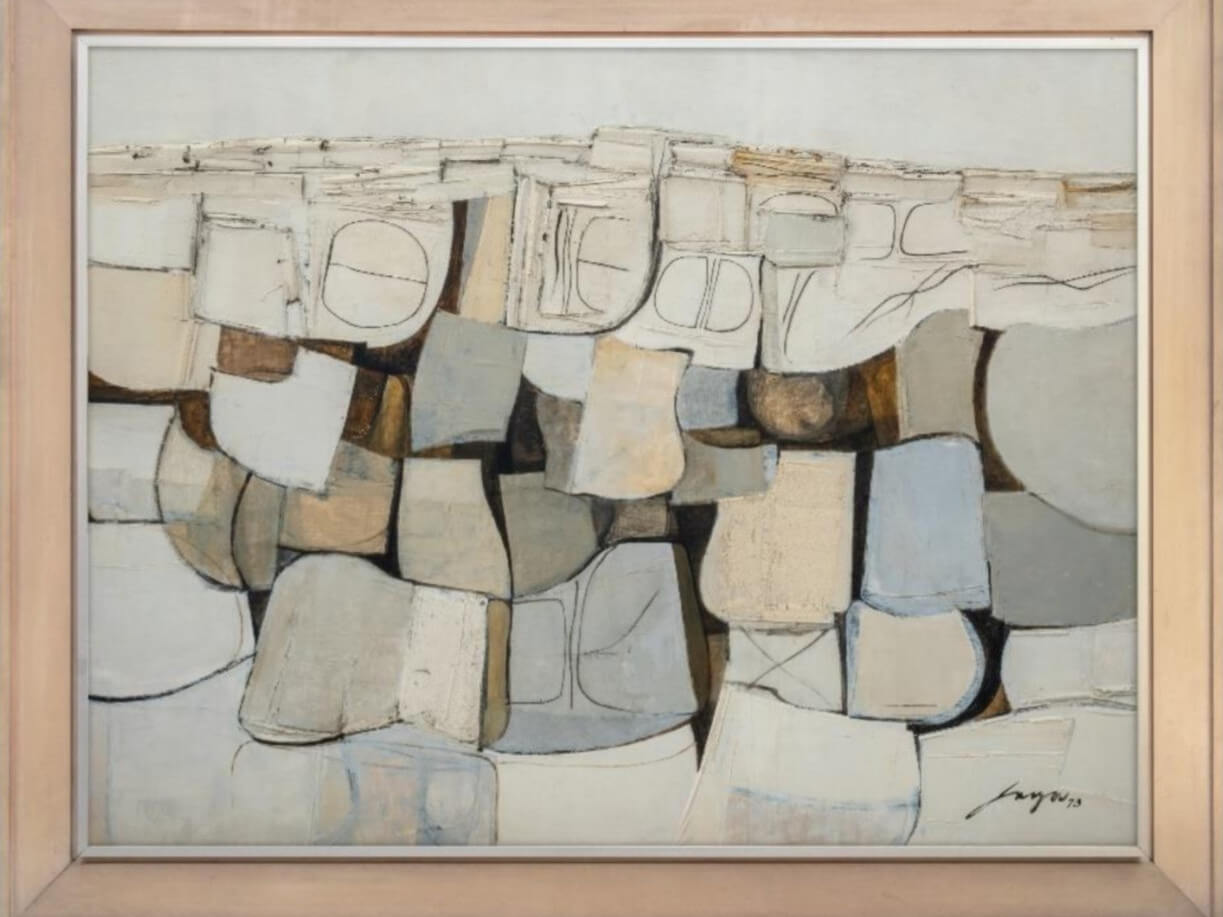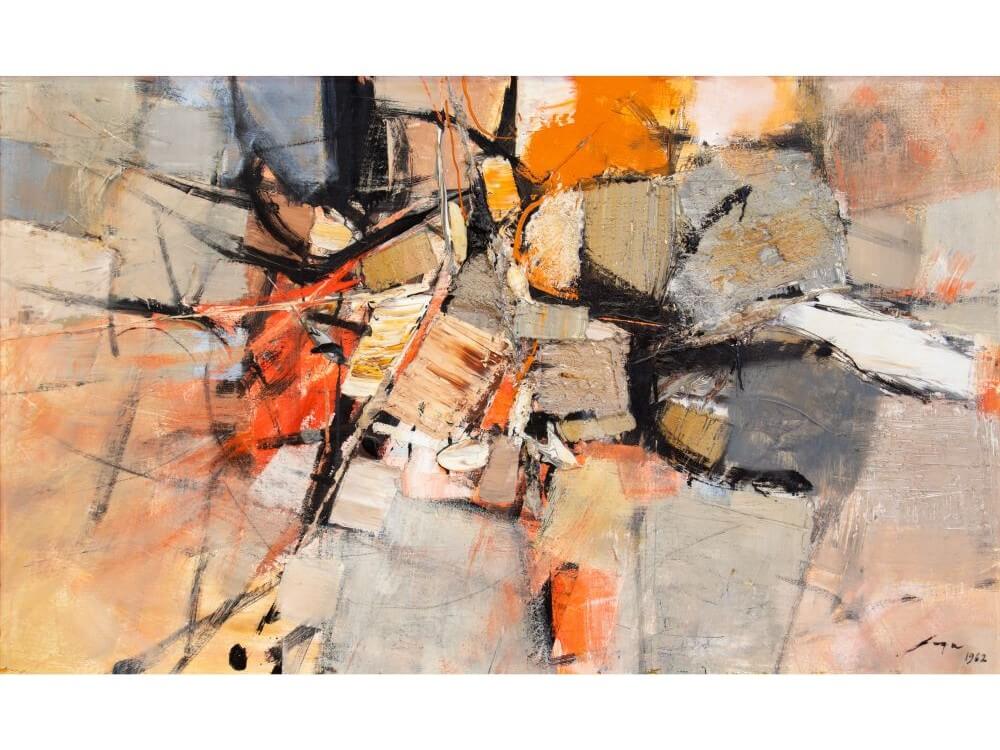

Titled Morning Mist, Hangchow, the work encapsulates Joya at his creative and commercial peak.
By the 1970s, Joya was not only the brightest name in Philippine art but the most “booked and busy” of them all.He had become the first-ever Filipino visual artist to be granted the Rockefeller scholarship fund — in fact, twice successively: the John D. Rockefeller III Foundation grant in 1967 and the Ford Foundation Assistance in 1968.
Joya also participated in a 1970 traveling exhibit that visited New York, the Smithsonian Institute, the Denver Art Museum, Los Angeles, San Francisco, Chicago, Minneapolis, and Atlanta.Upon returning to the Philippines, Joya mounted a homecoming exhibition.
In 1970, he was anointed as an Associate Professor and new Dean of his alma mater, the UP College of Fine Arts. In 1971, he added another award to his string of accolades — the “Patnubay ng Kalinangan Award,’ bestowed by the City of Manila during its fourth centennial celebrations.
Two years later, in 1973, Joya would be listed (along with Rod. Paras-Perez) in the prestigious London-published “International Who’s Who in Art and Antiques.” Winding back just a few years, in 1964, Joya, along with Abueva, represented the Philippines in its historic first participation at “The Olympics of the Art World” — the Venice Biennale.
Visit to China
Morning Mist, Hangchow was also the product of Joya’s 16-day trip to the People’s Republic of China in mid-1972. As chairperson of the Philippine First Educators’ Group Delegation, Joya flew to China to formally present a letter of invitation to the Art Society of Peking to attend the Southeast Asian Regional Artists Conference, of which he was also secretary-general.
Joya was also tasked to travel to Hong Kong to invite its artists to the conference and personally request that the influential Asia Magazine publish a special issue of Southeast Asian art. In China, Joya found more than spare time to immerse himself in Chinese culture and society, sketching people and places and visiting iconic landmarks: the Great Wall, Forbidden City, Tiananmen Square, and the Peking Palace of Fine Arts.
He also visited major cities: Beijing, Canton, Nanjing, Shanghai, and Hangzhou, from which Joya drew inspiration for the work at hand, Morning Mist, Hangchow.
Painted on February 4, 1973, almost a year after his Chinese sojourn, this work shows Joya’s fondness for his visit to China.
“In fact, I had just left the border when I thought of going back. That’s how much I liked the place,” Joya said in a 12 July 1972 Manila Bulletin interview. Joya likely depicts in this work Hangzhou’s famed West Lake, which, especially on mornings, becomes laden with mist, seemingly transforming the lake and its surrounding landscapes into a Chinese ink-wash painting.
West Lake has inspired many painters and poets since the 9th century and was declared by UNESCO as a World Heritage Site in 2011 for influencing garden design in China, Japan, and Korea. Joya’s employment of a cool and sweet pastel-like palette illuminated by a bluish-gray tone captures this scenario.
Luz Gallery homecoming
Morning Mist, Hangchow would become part of Joya’s blockbuster exhibition at the Luz Gallery in November 1973, from which the owner acquired the work.
Titled “Joya: New Paintings,” it showcased oil paintings and was the show that first introduced to the public his career-defining acrylic collages. The work encapsulates Joya’s consummate evolution from his artistry-defining abstract expressionism of the ‘50s and ‘60s to geometric expressionism characterized by a succession of weaved block-like forms, which borrowed elements from the seriality of Pop Art, the dominant art style in America in the 1960s when Joya pursued his Rockefeller grant.
Rediscovery of the Filipino sensibility
But Joya’s venture into geometric expressionism aligns more with a Filipino sensibility. While Pop Art’s seriality critiques mass production, consumerism, and media saturation, Joya’s geometric abstraction was influenced by an intimate reconnection with the cultures of his motherland.
In 1967, when Joya had just settled in New York for his scholarship, he became engrossed with the study of Philippine history— probably a sign of part homesickness, part curiosity, and part reawakening in him.
"At this time, the study of Philippine history engaged me,” Joya says in Leonidas Benesa’s Joya: Drawings. “Digging into rare sources, I came across materials that gave light facets to Philippine history."
Furthermore, this reinvigorated spirit in Joya coincided with the resurgence of nationalistic and progressive ideals during the tumultuous 60s (also the era of the wars of national liberation against imperialism in many nations like Cuba, Vietnam, and the Philippines), in which the search for a pre-colonial past became intertwined with the concept of nation-building and the decolonization of Philippine history. Joya’s interest also coincided with the rise of nationalist historiography fostered by the eminent Teodoro Agoncillo and Renato Constantino.
Despite the foreign subject matter, Morning Mist, Hangchow is a sublime articulation of a Filipino visual language that would reach a high point in his monumental 1976 painting “Pagdiriwang” (PICC Collection), which Joya said is “the celebration of the Filipino’s struggle to discover himself and assert his own position in the universal society of men…a tribute to the Filipino’s pride in his own identity.” – Adrian Maranan for Leon Gallery
The Spectacular Mid-Year Auction will be held on June 8, 2024, at 2 PM at Eurovilla 1, Rufino corner Legazpi Streets, Legazpi Village, Makati City. Preview week is from June 1 to June 7, 2024, from 9 AM to 7 PM. For further inquiries, email info@leon-gallery.com or contact +632 8856-27-81. To browse the catalog, visit www.leon-gallery.com. Follow León Gallery on their social media pages for timely updates: Facebook - www.facebook.com/leongallerymakati and Instagram @leongallerymakati.

